Spring 2019 GEN 301 Professional Ethics Assignment Solution
VerifiedAdded on 2023/01/19
|6
|1291
|42
Homework Assignment
AI Summary
This document presents a complete solution to a Professional Ethics assignment (GEN 301, Spring 2019). The assignment addresses three key questions: First, it explores how diffusion of responsibility and conformity can lead to unethical behavior within organizations. Second, it compares and contrasts consequentialist and non-consequentialist ethical theories, outlining the advantages and disadvantages of each. Finally, it explains John Rawls' concept of the veil of ignorance and evaluates whether it ensures justice for all. The solution provides detailed explanations, definitions, and examples to support the answers to each question, referencing relevant academic literature. The assignment aims to provide a comprehensive understanding of ethical principles and their application in a professional context.
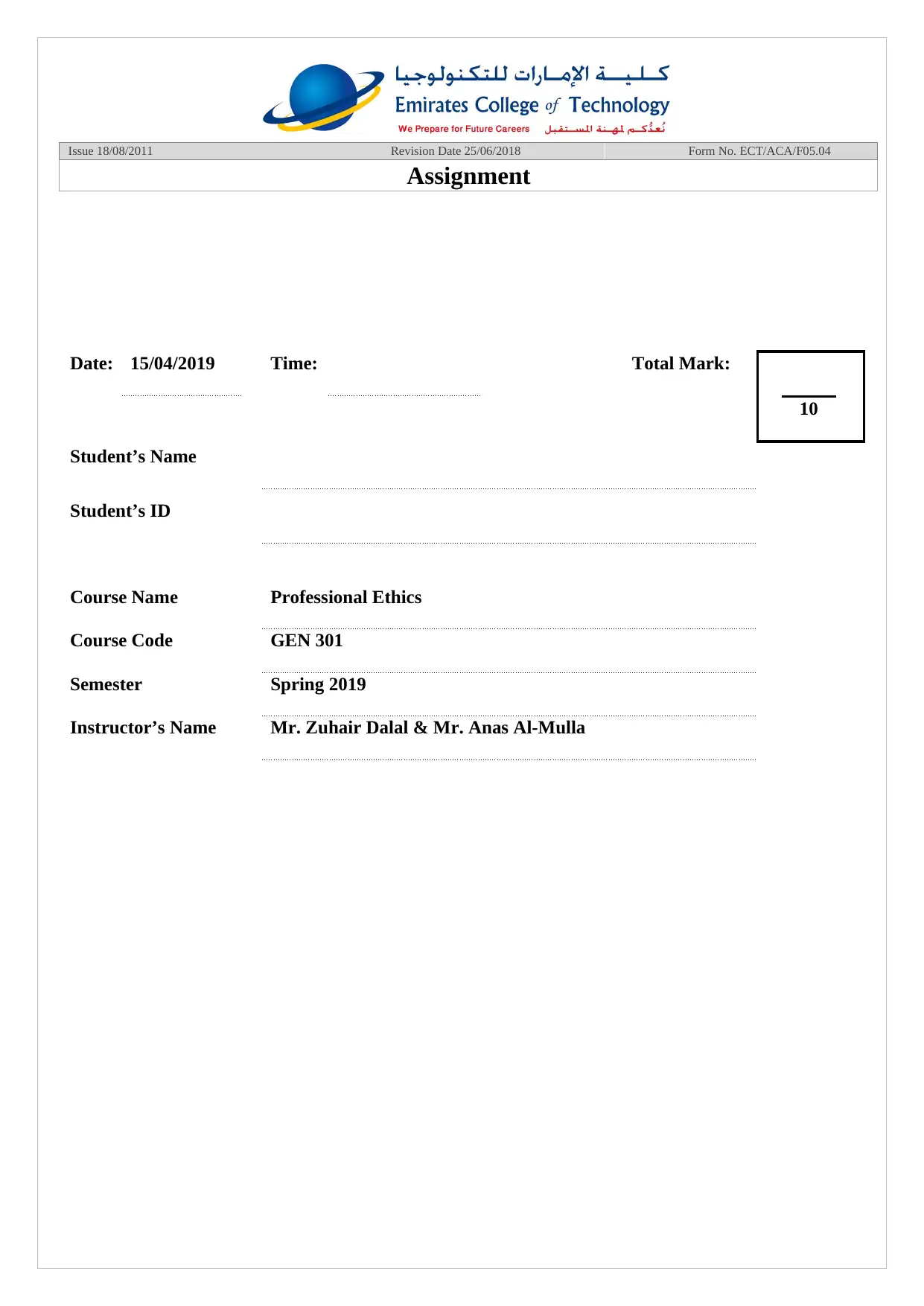
Issue 18/08/2011 Revision Date 25/06/2018 Form No. ECT/ACA/F05.04
Assignment
Date: 15/04/2019 Time: Total Mark:
10
Student’s Name
Student’s ID
Course Name Professional Ethics
Course Code GEN 301
Semester Spring 2019
Instructor’s Name Mr. Zuhair Dalal & Mr. Anas Al-Mulla
Assignment
Date: 15/04/2019 Time: Total Mark:
10
Student’s Name
Student’s ID
Course Name Professional Ethics
Course Code GEN 301
Semester Spring 2019
Instructor’s Name Mr. Zuhair Dalal & Mr. Anas Al-Mulla
Paraphrase This Document
Need a fresh take? Get an instant paraphrase of this document with our AI Paraphraser
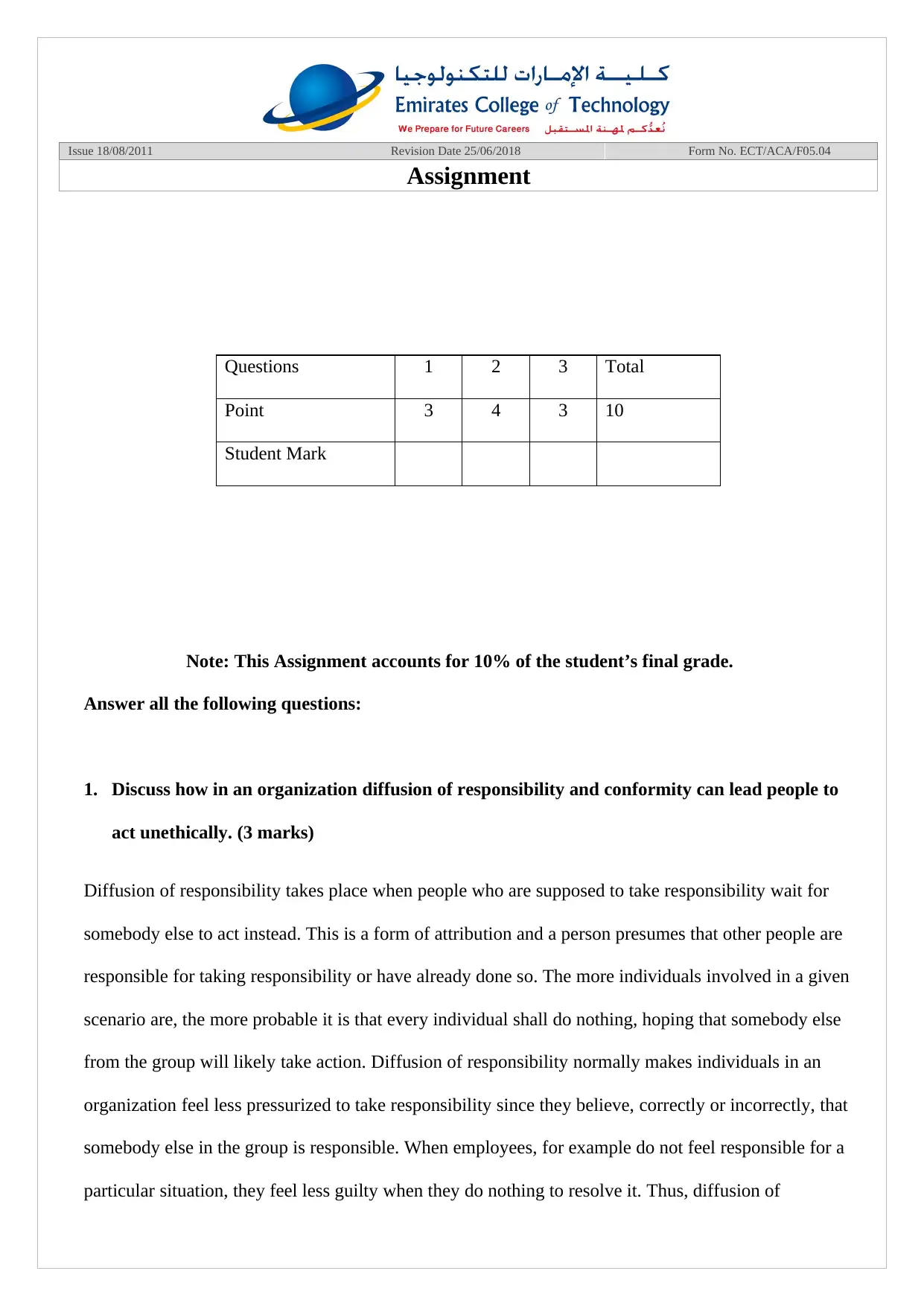
Issue 18/08/2011 Revision Date 25/06/2018 Form No. ECT/ACA/F05.04
Assignment
Note: This Assignment accounts for 10% of the student’s final grade.
Answer all the following questions:
1. Discuss how in an organization diffusion of responsibility and conformity can lead people to
act unethically. (3 marks)
Diffusion of responsibility takes place when people who are supposed to take responsibility wait for
somebody else to act instead. This is a form of attribution and a person presumes that other people are
responsible for taking responsibility or have already done so. The more individuals involved in a given
scenario are, the more probable it is that every individual shall do nothing, hoping that somebody else
from the group will likely take action. Diffusion of responsibility normally makes individuals in an
organization feel less pressurized to take responsibility since they believe, correctly or incorrectly, that
somebody else in the group is responsible. When employees, for example do not feel responsible for a
particular situation, they feel less guilty when they do nothing to resolve it. Thus, diffusion of
Questions 1 2 3 Total
Point 3 4 3 10
Student Mark
Assignment
Note: This Assignment accounts for 10% of the student’s final grade.
Answer all the following questions:
1. Discuss how in an organization diffusion of responsibility and conformity can lead people to
act unethically. (3 marks)
Diffusion of responsibility takes place when people who are supposed to take responsibility wait for
somebody else to act instead. This is a form of attribution and a person presumes that other people are
responsible for taking responsibility or have already done so. The more individuals involved in a given
scenario are, the more probable it is that every individual shall do nothing, hoping that somebody else
from the group will likely take action. Diffusion of responsibility normally makes individuals in an
organization feel less pressurized to take responsibility since they believe, correctly or incorrectly, that
somebody else in the group is responsible. When employees, for example do not feel responsible for a
particular situation, they feel less guilty when they do nothing to resolve it. Thus, diffusion of
Questions 1 2 3 Total
Point 3 4 3 10
Student Mark
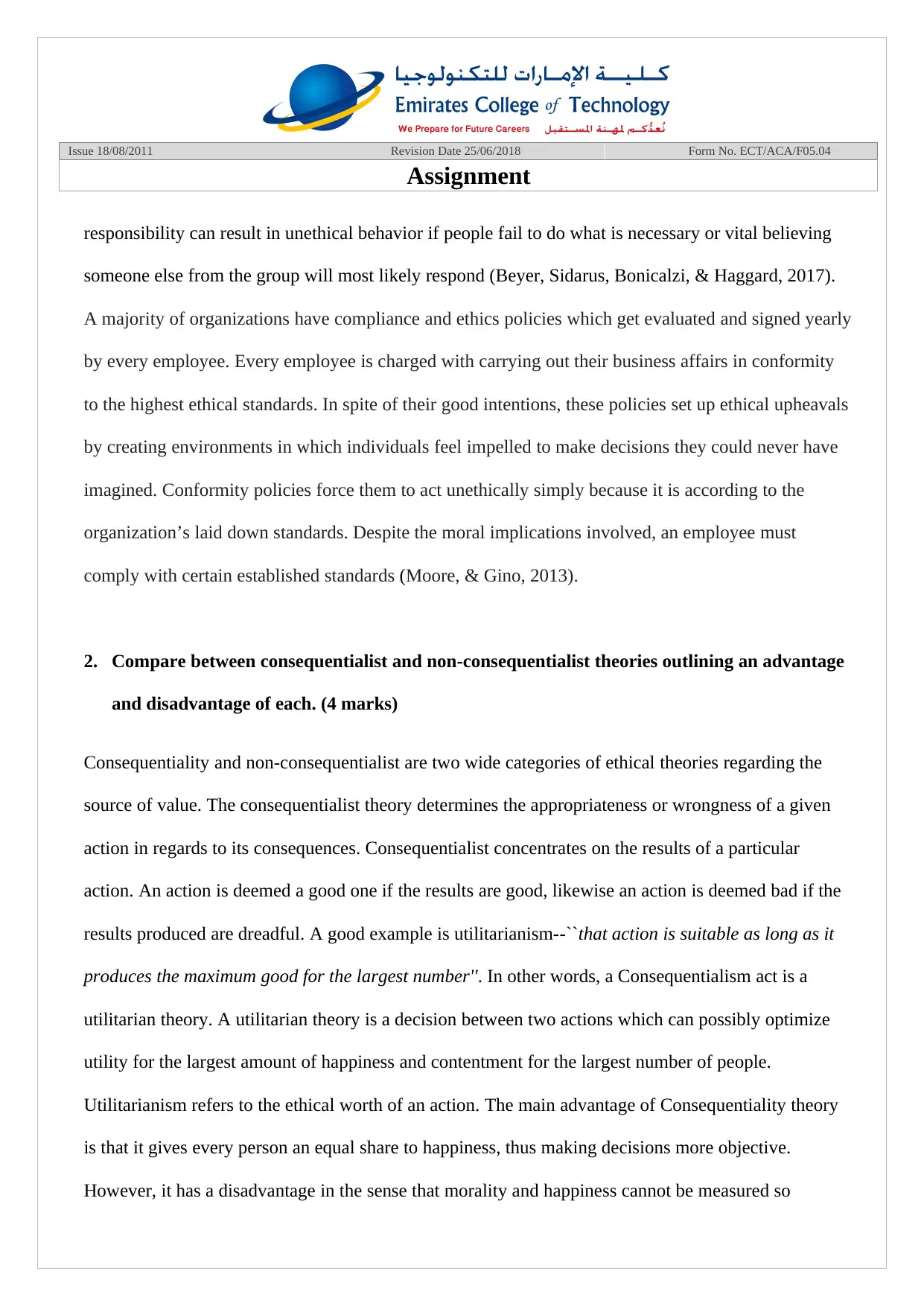
Issue 18/08/2011 Revision Date 25/06/2018 Form No. ECT/ACA/F05.04
Assignment
responsibility can result in unethical behavior if people fail to do what is necessary or vital believing
someone else from the group will most likely respond (Beyer, Sidarus, Bonicalzi, & Haggard, 2017).
A majority of organizations have compliance and ethics policies which get evaluated and signed yearly
by every employee. Every employee is charged with carrying out their business affairs in conformity
to the highest ethical standards. In spite of their good intentions, these policies set up ethical upheavals
by creating environments in which individuals feel impelled to make decisions they could never have
imagined. Conformity policies force them to act unethically simply because it is according to the
organization’s laid down standards. Despite the moral implications involved, an employee must
comply with certain established standards (Moore, & Gino, 2013).
2. Compare between consequentialist and non-consequentialist theories outlining an advantage
and disadvantage of each. (4 marks)
Consequentiality and non-consequentialist are two wide categories of ethical theories regarding the
source of value. The consequentialist theory determines the appropriateness or wrongness of a given
action in regards to its consequences. Consequentialist concentrates on the results of a particular
action. An action is deemed a good one if the results are good, likewise an action is deemed bad if the
results produced are dreadful. A good example is utilitarianism--``that action is suitable as long as it
produces the maximum good for the largest number''. In other words, a Consequentialism act is a
utilitarian theory. A utilitarian theory is a decision between two actions which can possibly optimize
utility for the largest amount of happiness and contentment for the largest number of people.
Utilitarianism refers to the ethical worth of an action. The main advantage of Consequentiality theory
is that it gives every person an equal share to happiness, thus making decisions more objective.
However, it has a disadvantage in the sense that morality and happiness cannot be measured so
Assignment
responsibility can result in unethical behavior if people fail to do what is necessary or vital believing
someone else from the group will most likely respond (Beyer, Sidarus, Bonicalzi, & Haggard, 2017).
A majority of organizations have compliance and ethics policies which get evaluated and signed yearly
by every employee. Every employee is charged with carrying out their business affairs in conformity
to the highest ethical standards. In spite of their good intentions, these policies set up ethical upheavals
by creating environments in which individuals feel impelled to make decisions they could never have
imagined. Conformity policies force them to act unethically simply because it is according to the
organization’s laid down standards. Despite the moral implications involved, an employee must
comply with certain established standards (Moore, & Gino, 2013).
2. Compare between consequentialist and non-consequentialist theories outlining an advantage
and disadvantage of each. (4 marks)
Consequentiality and non-consequentialist are two wide categories of ethical theories regarding the
source of value. The consequentialist theory determines the appropriateness or wrongness of a given
action in regards to its consequences. Consequentialist concentrates on the results of a particular
action. An action is deemed a good one if the results are good, likewise an action is deemed bad if the
results produced are dreadful. A good example is utilitarianism--``that action is suitable as long as it
produces the maximum good for the largest number''. In other words, a Consequentialism act is a
utilitarian theory. A utilitarian theory is a decision between two actions which can possibly optimize
utility for the largest amount of happiness and contentment for the largest number of people.
Utilitarianism refers to the ethical worth of an action. The main advantage of Consequentiality theory
is that it gives every person an equal share to happiness, thus making decisions more objective.
However, it has a disadvantage in the sense that morality and happiness cannot be measured so
⊘ This is a preview!⊘
Do you want full access?
Subscribe today to unlock all pages.

Trusted by 1+ million students worldwide
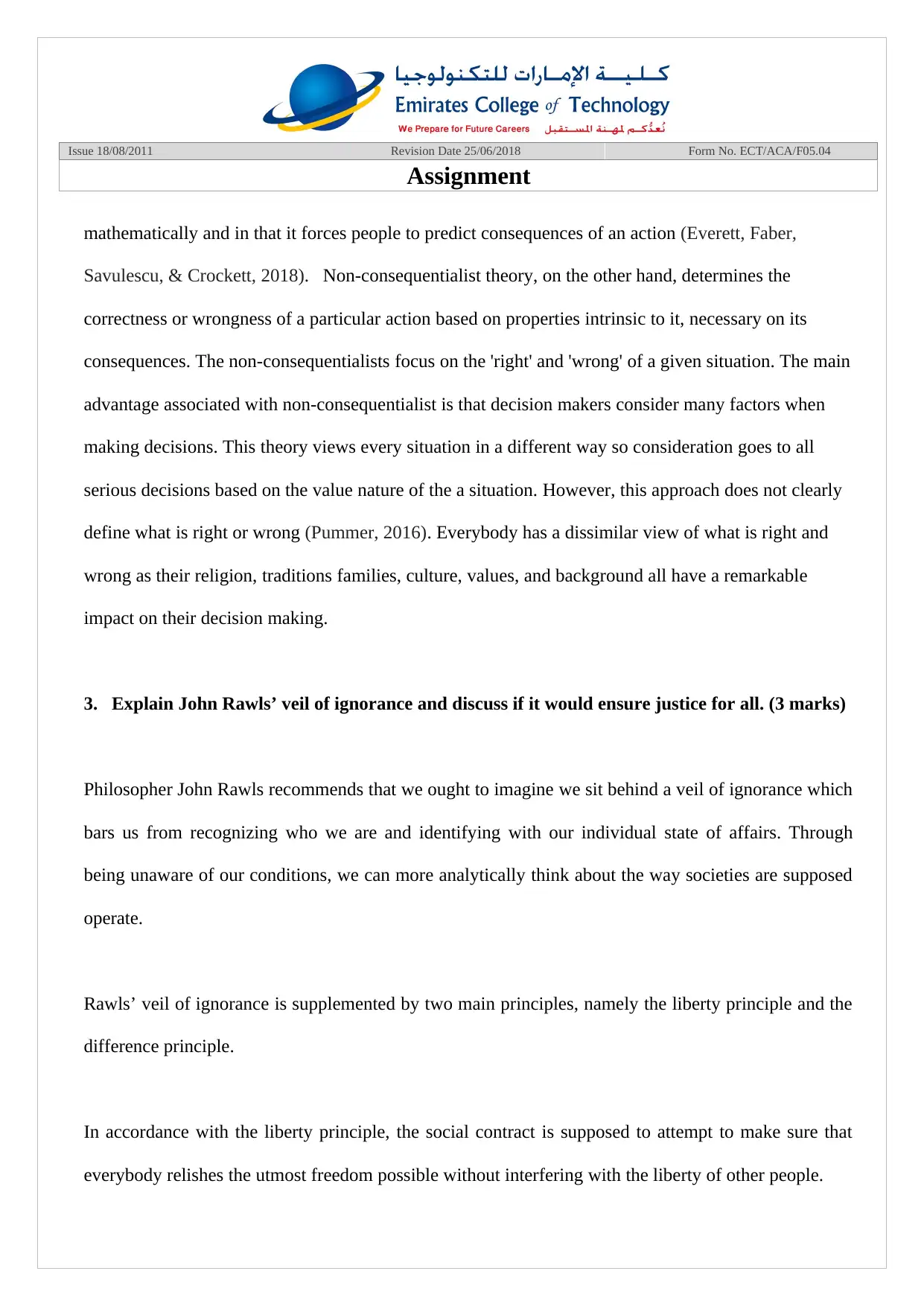
Issue 18/08/2011 Revision Date 25/06/2018 Form No. ECT/ACA/F05.04
Assignment
mathematically and in that it forces people to predict consequences of an action (Everett, Faber,
Savulescu, & Crockett, 2018). Non-consequentialist theory, on the other hand, determines the
correctness or wrongness of a particular action based on properties intrinsic to it, necessary on its
consequences. The non-consequentialists focus on the 'right' and 'wrong' of a given situation. The main
advantage associated with non-consequentialist is that decision makers consider many factors when
making decisions. This theory views every situation in a different way so consideration goes to all
serious decisions based on the value nature of the a situation. However, this approach does not clearly
define what is right or wrong (Pummer, 2016). Everybody has a dissimilar view of what is right and
wrong as their religion, traditions families, culture, values, and background all have a remarkable
impact on their decision making.
3. Explain John Rawls’ veil of ignorance and discuss if it would ensure justice for all. (3 marks)
Philosopher John Rawls recommends that we ought to imagine we sit behind a veil of ignorance which
bars us from recognizing who we are and identifying with our individual state of affairs. Through
being unaware of our conditions, we can more analytically think about the way societies are supposed
operate.
Rawls’ veil of ignorance is supplemented by two main principles, namely the liberty principle and the
difference principle.
In accordance with the liberty principle, the social contract is supposed to attempt to make sure that
everybody relishes the utmost freedom possible without interfering with the liberty of other people.
Assignment
mathematically and in that it forces people to predict consequences of an action (Everett, Faber,
Savulescu, & Crockett, 2018). Non-consequentialist theory, on the other hand, determines the
correctness or wrongness of a particular action based on properties intrinsic to it, necessary on its
consequences. The non-consequentialists focus on the 'right' and 'wrong' of a given situation. The main
advantage associated with non-consequentialist is that decision makers consider many factors when
making decisions. This theory views every situation in a different way so consideration goes to all
serious decisions based on the value nature of the a situation. However, this approach does not clearly
define what is right or wrong (Pummer, 2016). Everybody has a dissimilar view of what is right and
wrong as their religion, traditions families, culture, values, and background all have a remarkable
impact on their decision making.
3. Explain John Rawls’ veil of ignorance and discuss if it would ensure justice for all. (3 marks)
Philosopher John Rawls recommends that we ought to imagine we sit behind a veil of ignorance which
bars us from recognizing who we are and identifying with our individual state of affairs. Through
being unaware of our conditions, we can more analytically think about the way societies are supposed
operate.
Rawls’ veil of ignorance is supplemented by two main principles, namely the liberty principle and the
difference principle.
In accordance with the liberty principle, the social contract is supposed to attempt to make sure that
everybody relishes the utmost freedom possible without interfering with the liberty of other people.
Paraphrase This Document
Need a fresh take? Get an instant paraphrase of this document with our AI Paraphraser
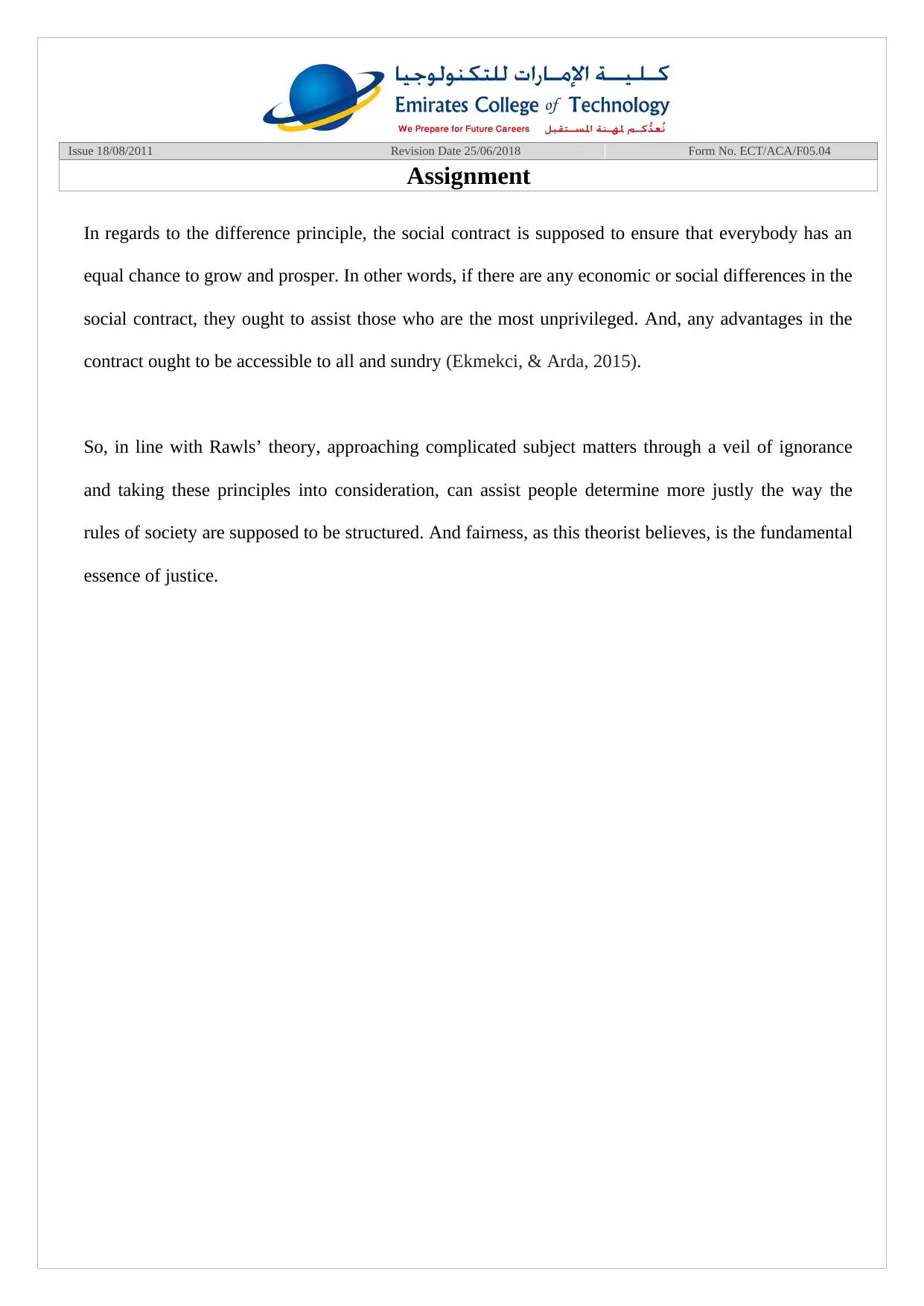
Issue 18/08/2011 Revision Date 25/06/2018 Form No. ECT/ACA/F05.04
Assignment
In regards to the difference principle, the social contract is supposed to ensure that everybody has an
equal chance to grow and prosper. In other words, if there are any economic or social differences in the
social contract, they ought to assist those who are the most unprivileged. And, any advantages in the
contract ought to be accessible to all and sundry (Ekmekci, & Arda, 2015).
So, in line with Rawls’ theory, approaching complicated subject matters through a veil of ignorance
and taking these principles into consideration, can assist people determine more justly the way the
rules of society are supposed to be structured. And fairness, as this theorist believes, is the fundamental
essence of justice.
Assignment
In regards to the difference principle, the social contract is supposed to ensure that everybody has an
equal chance to grow and prosper. In other words, if there are any economic or social differences in the
social contract, they ought to assist those who are the most unprivileged. And, any advantages in the
contract ought to be accessible to all and sundry (Ekmekci, & Arda, 2015).
So, in line with Rawls’ theory, approaching complicated subject matters through a veil of ignorance
and taking these principles into consideration, can assist people determine more justly the way the
rules of society are supposed to be structured. And fairness, as this theorist believes, is the fundamental
essence of justice.
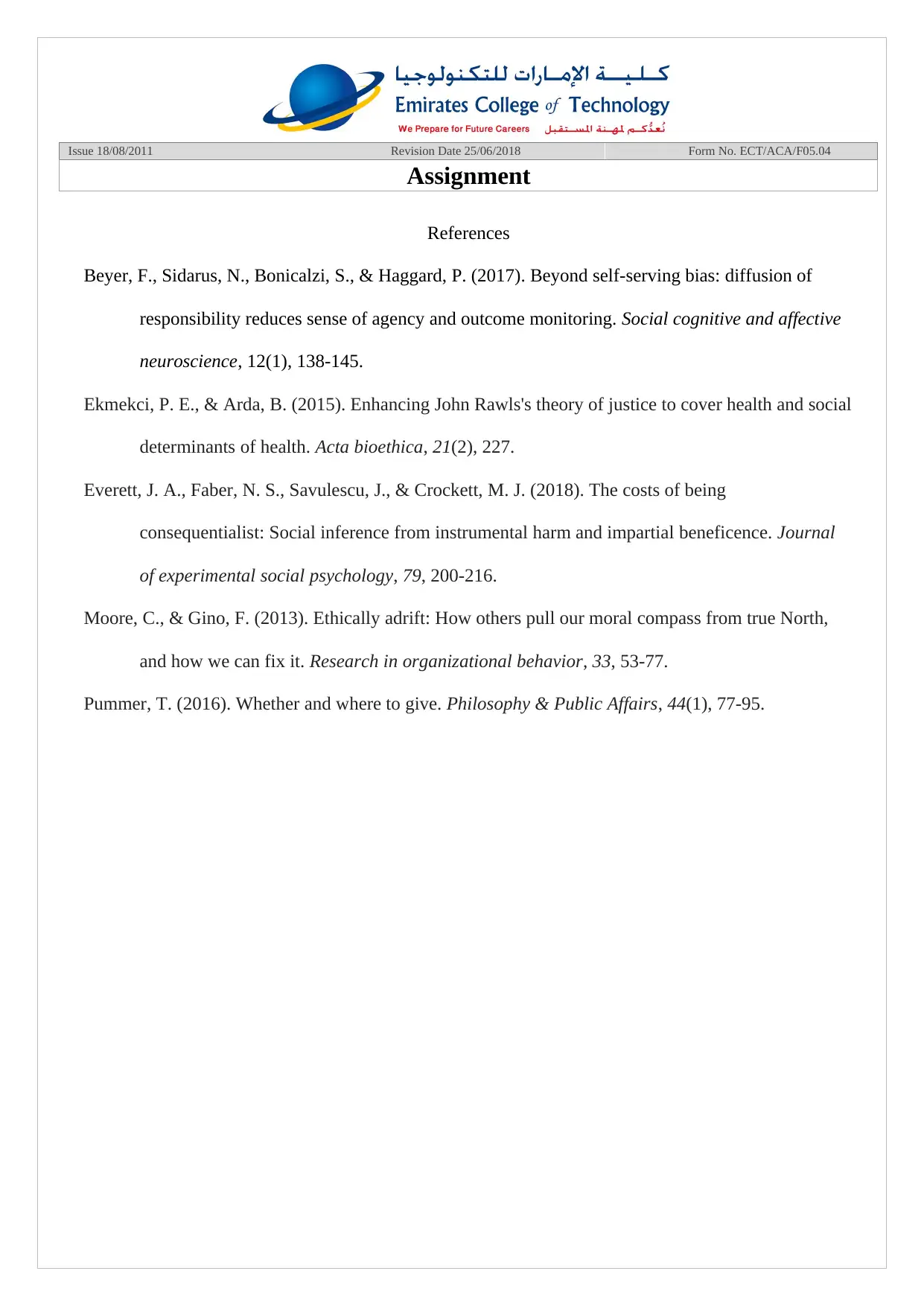
Issue 18/08/2011 Revision Date 25/06/2018 Form No. ECT/ACA/F05.04
Assignment
References
Beyer, F., Sidarus, N., Bonicalzi, S., & Haggard, P. (2017). Beyond self-serving bias: diffusion of
responsibility reduces sense of agency and outcome monitoring. Social cognitive and affective
neuroscience, 12(1), 138-145.
Ekmekci, P. E., & Arda, B. (2015). Enhancing John Rawls's theory of justice to cover health and social
determinants of health. Acta bioethica, 21(2), 227.
Everett, J. A., Faber, N. S., Savulescu, J., & Crockett, M. J. (2018). The costs of being
consequentialist: Social inference from instrumental harm and impartial beneficence. Journal
of experimental social psychology, 79, 200-216.
Moore, C., & Gino, F. (2013). Ethically adrift: How others pull our moral compass from true North,
and how we can fix it. Research in organizational behavior, 33, 53-77.
Pummer, T. (2016). Whether and where to give. Philosophy & Public Affairs, 44(1), 77-95.
Assignment
References
Beyer, F., Sidarus, N., Bonicalzi, S., & Haggard, P. (2017). Beyond self-serving bias: diffusion of
responsibility reduces sense of agency and outcome monitoring. Social cognitive and affective
neuroscience, 12(1), 138-145.
Ekmekci, P. E., & Arda, B. (2015). Enhancing John Rawls's theory of justice to cover health and social
determinants of health. Acta bioethica, 21(2), 227.
Everett, J. A., Faber, N. S., Savulescu, J., & Crockett, M. J. (2018). The costs of being
consequentialist: Social inference from instrumental harm and impartial beneficence. Journal
of experimental social psychology, 79, 200-216.
Moore, C., & Gino, F. (2013). Ethically adrift: How others pull our moral compass from true North,
and how we can fix it. Research in organizational behavior, 33, 53-77.
Pummer, T. (2016). Whether and where to give. Philosophy & Public Affairs, 44(1), 77-95.
⊘ This is a preview!⊘
Do you want full access?
Subscribe today to unlock all pages.

Trusted by 1+ million students worldwide
1 out of 6
Your All-in-One AI-Powered Toolkit for Academic Success.
+13062052269
info@desklib.com
Available 24*7 on WhatsApp / Email
![[object Object]](/_next/static/media/star-bottom.7253800d.svg)
Unlock your academic potential
Copyright © 2020–2025 A2Z Services. All Rights Reserved. Developed and managed by ZUCOL.
